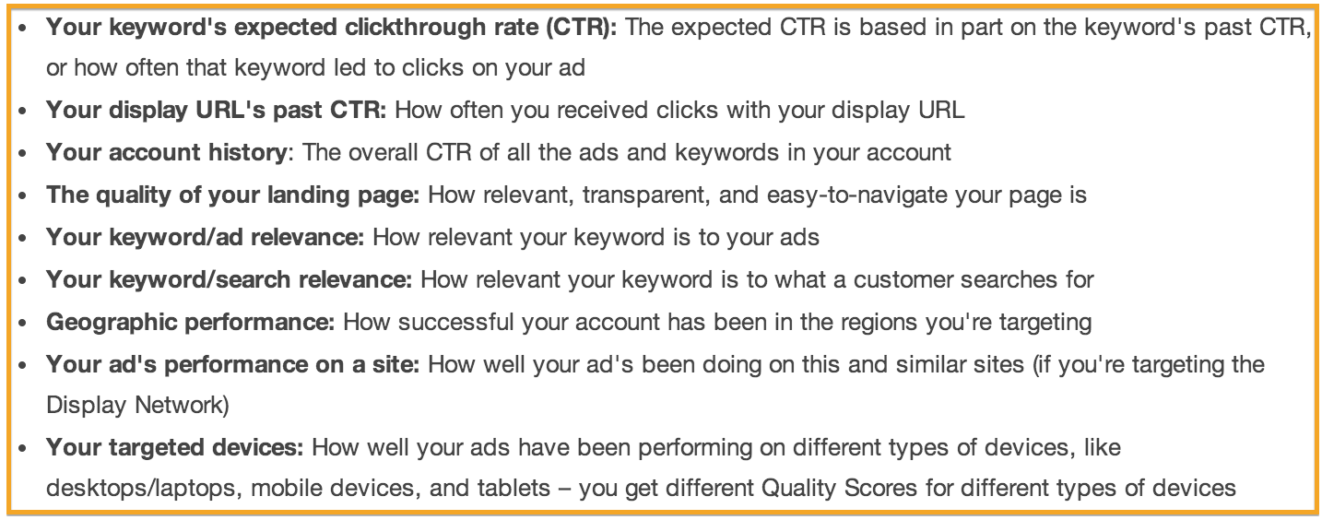“We’ve worked really hard on improving CTR, but Quality Scores are actually going down. How is that possible?”
Back in October I wrote a post about how you can improve your account’s CTR and recently I’ve started to feel a little guilty about all that advice. I spent the entire article talking about how to increase click-through rates knowing full well that many advertisers see CTR as the gateway to higher Quality Scores. Click-through rate is absolutely one piece of the Quality Score puzzle, but putting CTR before a true Quality Score strategy can do more harm than good. Perhaps not even more harm than good, but it could make more work for you later on.
Quick refresher course on how Quality Score is determined (thank you to AdWords Help for the screenshot!):
So you see – a piece of the puzzle, CTR is; but it isn’t the only piece.
In fact, if you’re pushing through a larger volume of clicks to an irrelevant landing page, you’re simply increasing the number of times a searcher doesn’t find what they’re looking for and you’ll end up with a worse Quality Score than before you started. It’s frustrating, and again…I’m sorry for not mentioning this more directly before.
The way you have to attack Quality Score and/or CTR is by knowing the other will be affected or altered by the other, but you have to strategize them together as much as possible. Then also add in the other factors listed above. No big deal, right?
To summarize before we jump in to the other factors of Quality Score that you can work on – increasing CTR will not always improve Quality Scores, and vice versa. It is more than possible, however, to put together a targeted strategy specific to Quality Score to make sure when those CTRs do go up – it’s for the right reasons, in the right way, and continues to improve Quality Score as it goes.
Some things to remember…
Account and account element Quality Scores, while historically untrackable unless you’re utilizing a seriously rad tool like Quality Score Monitor, are like the ghost of Christmas past; they’ll come back to haunt you eventually. Particular facets of specific keyword or ad copy get judged on their current performance, but also on their historical CTRs. This also includes the previous or past Quality Scores of your entire account as more of a historical average. Those are some doodles that can’t be undid, home skillet. You can be putting all the perfect tactics in place and still not get that one or two final Quality Score points because of previous poor structure, CTRs, etc.
Next, did you take some time to audit and/or improve your account structure for improved relevance before you started pushing click-throughs? What about the landing pages those clicks are going to? I’m getting ahead of myself again, because don’t even look at your landing pages until the structure part is taken care of. If you’ve got more than 5-10 (or maybe even more than 5 period) keywords in an individual ad group, the odds are pretty high that you can’t write an ad copy to speak to those different potential queries that triggered your ad. If the ad copy doesn’t read as what the consumer wants, hopefully they don’t click. Let’s say you jacked up your bid to get a higher position, however. So your likelihood of unqualified clicks could go up with greater visibility.
Then that user gets to a landing page that, similar to your ad copy, more than likely does not directly include those terms you’ve bid on with that ad group. Maybe it has a version of the terms, but from a Quality Score standpoint…almost doesn’t count. I’m a huge proponent of PPC-specific landing pages, and ad group-specific ones where possible. This will allow for direct keyword inclusion and copy to be written or that page to be designed in a way that continues pushing each individual consumer through your sales funnel effectively. Happy consumers = happy search engine = higher (read: sustainable) Quality Scores.
Finally, you have to allow room for your particular campaign or ad group targeting in to consideration when evaluating why your Quality Scores may not have improved with better CTRs. I’m talking networks, locations/geotargets, and (this should be no surprise) devices.
Google judges how well your image or text ads have performed on any particular Display placement or site in the past and present when determining Quality Scores for that network. This one can be particularly upsetting, because you don’t exactly control how that website is managed, so poor performance on the site (and hey, maybe you should have excluded it) could be sticking with that particular placement today and making it hard to gain traction, even with better click-through on that ad or site.
The same goes for geographic or location targeting. If you’ve done well in that location in the past, this probably isn’t a big deal. If you haven’t – you’re going to always battle a little hurdle you can’t clear with Quality Score due to historical performance.
And let’s really not act like we don’t obviously expect AdWords to be super judgy-wudgy about device performance when it comes to Quality Score. They want to see different ad copy and different landing pages for different devices, and they give you a separate score per device to keep it interesting.
To beat the drum one more time as Jeff Allen says…
Quality Score may sound simple, and a lot of emphasis may be put on click-through rate as the best way to get there, but always remember who is behind the ultimate controls – the search engine.
Higher click-throughs are good for them because it means more clicks and more budget spent. Look at what will make your account healthiest, first…then go to bat with the engine in question and only push your CTR when account structure and landing pages are ready for it.
What are your favorite or most successful Quality Score improving tactics? Please reach out to us on Twitter @ppchero!




